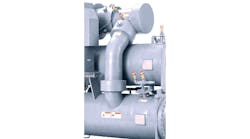If you are facing the costly challenge of replacing a chiller, the government has some free and credible guidance for you based on extensive testing.
The GSA’s Green Proving Ground (GPG) program evaluates building technologies under real-world conditions across the agency’s immense portfolio. The program provides succinct summaries and recommendations based on GSA’s investments in new technologies not yet widely deployed in the buildings industry.
GPG’s evaluation of chillers notes that efficiency and ease of operation have increased over the past 15 years but that there are significant differences in the design of equipment now available on the market.
For its test-bed evaluation, GPG used the Sidney R. Yates Federal Building in Washington, D.C., a 208,000-square-foot historic facility completed in 1880 and currently occupied by the U.S. Forest Service. A 2013 renovation of the building included a new building automation system.
GSA installed two different chillers to the same chilled water and condenser loops to create conditions as identical as possible to a real-world application. The equipment types were a variable-speed magnetic bearing chiller (MBC) and a recent development, the variable-speed direct-drive screw chiller (VSS). To accommodate shifting loads, the MBC uses mechanical “unloaders” to release pressure and provide stable operation. The VSS meets shifting loads only by regulating motor speed.
Steps for Chiller Selection
■ Consult with a mechanical engineer to do a thorough economic and technical analysis including control optimization.
■ To size a replacement chiller correctly for peak cooling load, perform a new heat gain/loss calculation.
■ Evaluate your building’s cooling load profile. If the building spends most of its time at partial load, then prioritize energy consumption (kW/ton) at part loads. If the building operates 24/7/365 at comparatively high loads, then focus on efficiency at peak capacity.
■ Consider condenser water supply temperature during design. Magnetic bearing centrifugal chillers need to be optimized for water temperature while VSS compressors are a universal design.
■ Evaluate both your load and demand charges. If your building’s demand charges are high, thermal storage or load shifting may be cost-effective additions for a new chiller plant.
■ Consider the service provided in your area by prospective manufacturers.
In a previous study published in 2013, GSA reported that the MBC provided 42% energy savings compared to the conventional rotary compressor. In the new study, GSA and researchers from the Oak Ridge National Laboratory (ORNL) measured similar performance from the VSS and MBC. Both are considered to be good options for end-of-life replacements.
Researchers concluded that the VSS consumed an estimated 3.4% less energy on average than the MBC. The VSS chiller was also more versatile and able to perform in ambient conditions not typically found in Washington, D.C., from 55 degrees F. in spring to more than 95 degrees F. in summer. The VSS and MBC chillers had similar sound ratings at 77–83 decibels. Both had energy consumption measured at 35% better than the current Federal Energy Management Program (FEMP) minimum standard for water-cooled chillers.
For more information on the research, see the report, Variable-Speed Direct-Drive Screw Chiller, at www.gsa.gov/gpg.


